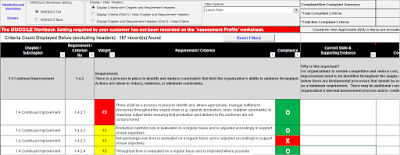This year (2015), we have carried out the 4th survey on risk management in the logistics industry. And - to put it in a nutshell: The situation, i.e. the degree of application and also (and even more important) the mind-set of logistics service providers regarding risk management has not changed. That is the main result of this year's survey - and you could stop here, if you are not interested in any details.
If you, however, would like to get a more detailed idea of what the status of risk management in this industry is, please do carry on...
Before we look at results, let me give you some numbers on the survey: The online questionaire used for the survey was available from March to April 2015. The survey was promoted using social media channels (xing.com) and by our media partner EuroTransportMedia Verlags- und Veranstaltungs-GmbH. 73 companies have answered our survey.
 |
| Figure 1: Top 5 future risks for logistics companies |
Although energy prices have decreased for some time, companies see fluctuations in energy prices as the #2 future risk. This is understandable, since energy cost are a major driver of total cost, especially for those companies with a focus on trucking.
It is interesting, that the top 5 risks differ from the top risks in the Allianz Risk Barometer (take a look at our blog entry from March 'Our number one is... Supply Chain Risks! (But beware of Cyber Crime!)': There, the top risks are business interruption and supply chain, natural catrastrophes, and fire and explosions. Cyber crime - a risk that is becoming more and more important - is not within the top 5 risks; however, 39 % of the LSP's see cyber risks as important risks.
 |
| Figure 2: Application of risk management in the logistics industry |
Even if competition is becoming stronger, logistics process chains show an increased complexity, and German law requires risk management, the application of risk management in the logistics industry is on a relatively low level. As figure 2 displays, only a little bit more than half of the LSP's have a risk management in place. Looking at the development from 2008 until now, the use of risk management has not changed much over time. Instead, the percentage values are more or less constant over time. We still see a group of some 25-30 % of the companies that do not have risk management in place, and also do not plan to implement risk management soon. Thus, the need for risk management is not seen by many logistic service providers.
 |
| Figure 3: Methods used in risk management in the logistics industry |
Those LSP's who have a running risk management in place, show - in average - only a medium level of maturity. Take, for example, the methods used for risk identification and assessment. As figure 3 shows, the methods most commonly used are expert and employee consultations, checklists and brainstorming. More sophisticated methods, such as FMEA, fault tree analysis, or simulation are only used by less the 3 out of 10 LSP's. Even risk maps, as an easy tool for communicating risks, are only used by 30 % of the companies. It is somehow irritating, that a risk inventory is not used by any of the companies - or that the term 'risk inventory' is maybe just unknown.
To sum it up: Comparing the results of our surveys over time, we do not see significant changes in both the application of and the maturity of risk management in the logistics industry. Both offer room for improvement. We forecast, however, an increasing pressure by customers, banks, and insurance companies on LSP's to implement a risk management system.
The full report Huth, M./Lohre, D.: Risikomanagement in der Speditions- und Logistikbranche: Bestandsaufnahme zu Verbreitung und Reifegrad, Discussion Papers in Business and Economics (17), Fulda 2015 (unfortunately only in Germna) can be downloaded here: fuldok.hs-fulda.de/opus4/frontdoor/index/index/docId/349





